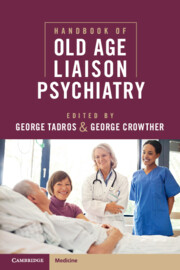Book contents
- Handbook of Old Age Liaison Psychiatry
- Handbook of Old Age Liaison Psychiatry
- Copyright page
- Contents
- Contributors
- Introduction
- Chapter 1 Psychological Well-Being in Later Life
- Chapter 2 The Epidemiology of Mental Illness in Older People in Acute Hospitals
- Chapter 3 Elderly-Friendly Care Settings and Hospitals
- Chapter 4 Communication with Older People
- Chapter 5 Privacy and Dignity in Acute Hospitals
- Chapter 6 Liaison Psychiatry and Law
- Chapter 7 Safeguarding Adults
- Chapter 8 Carers’ Needs before, during, and after Hospital Admissions
- Chapter 9 Dementia and Related Disorders
- Chapter 10 Behavioural and Psychological Symptoms of Dementia in Hospital Settings
- Chapter 11 Liaison Old Age Psychiatry Management of Delirium in Acute Hospitals
- Chapter 12 Depression and Associated Disorders
- Chapter 13 Prevention of Suicide and Self-Harm in Older People
- Chapter 14 Fear and Anxiety in Acute Settings
- Chapter 15 Late-Onset Psychosis and Related Disorders
- Chapter 16 Drug and Alcohol Misuse in Older People
- Chapter 17 Perioperative Medical Management of Older People
- Chapter 18 Parkinson’s Disease and Related Disorders in Acute Hospitals
- Chapter 19 Comprehensive Geriatric Assessment in Clinical Practice
- Chapter 20 Interface between Liaison Psychiatry Services for Older People and Wider Community Services
- Chapter 21 Psychometric Measures in Old Age Psychiatry
- Index
- References
Chapter 18 - Parkinson’s Disease and Related Disorders in Acute Hospitals
Published online by Cambridge University Press: 04 April 2024
- Handbook of Old Age Liaison Psychiatry
- Handbook of Old Age Liaison Psychiatry
- Copyright page
- Contents
- Contributors
- Introduction
- Chapter 1 Psychological Well-Being in Later Life
- Chapter 2 The Epidemiology of Mental Illness in Older People in Acute Hospitals
- Chapter 3 Elderly-Friendly Care Settings and Hospitals
- Chapter 4 Communication with Older People
- Chapter 5 Privacy and Dignity in Acute Hospitals
- Chapter 6 Liaison Psychiatry and Law
- Chapter 7 Safeguarding Adults
- Chapter 8 Carers’ Needs before, during, and after Hospital Admissions
- Chapter 9 Dementia and Related Disorders
- Chapter 10 Behavioural and Psychological Symptoms of Dementia in Hospital Settings
- Chapter 11 Liaison Old Age Psychiatry Management of Delirium in Acute Hospitals
- Chapter 12 Depression and Associated Disorders
- Chapter 13 Prevention of Suicide and Self-Harm in Older People
- Chapter 14 Fear and Anxiety in Acute Settings
- Chapter 15 Late-Onset Psychosis and Related Disorders
- Chapter 16 Drug and Alcohol Misuse in Older People
- Chapter 17 Perioperative Medical Management of Older People
- Chapter 18 Parkinson’s Disease and Related Disorders in Acute Hospitals
- Chapter 19 Comprehensive Geriatric Assessment in Clinical Practice
- Chapter 20 Interface between Liaison Psychiatry Services for Older People and Wider Community Services
- Chapter 21 Psychometric Measures in Old Age Psychiatry
- Index
- References
Summary
Parkinson’s is a commonly encountered condition in both acute hospitals and rehabilitation settings, particularly among older adults. It is also a true neuropsychiatric condition. People with Parkinson’s have both physical health and mental health morbidity, and the likelihood of a liaison psychiatrist being called to assess someone with Parkinson’s is therefore high. However, since this condition is often primarily thought of as a movement disorder rather thanas a neuropsychiatric disorder, the liaison psychiatrist may not have had much training in it, particularly in the physical problems that can occur. This chapter aims to provide the reader with a basic overview of Parkinson’s and related disorders, focusing on emergency presentations and problems that may occur during an acute admission, since these are the situations in which the liaison psychiatrist is most likely to be involved. Formatted to include tables and boxes, the chapter gives the reader easily digestible and clinically relevant information, with emphasis on the practical management of commonly encountered clinical problems rather than on theoretical information.
Keywords
- Type
- Chapter
- Information
- Handbook of Old Age Liaison Psychiatry , pp. 266 - 282Publisher: Cambridge University PressPrint publication year: 2024



